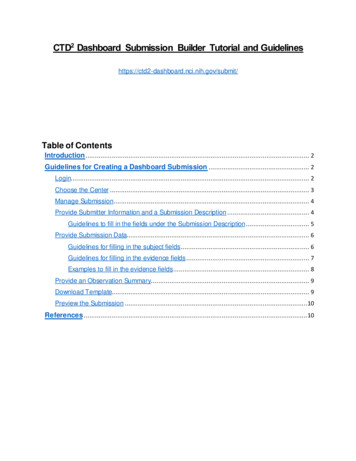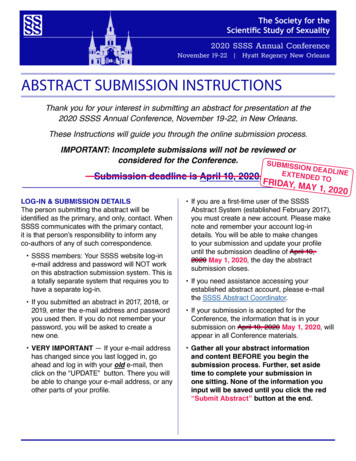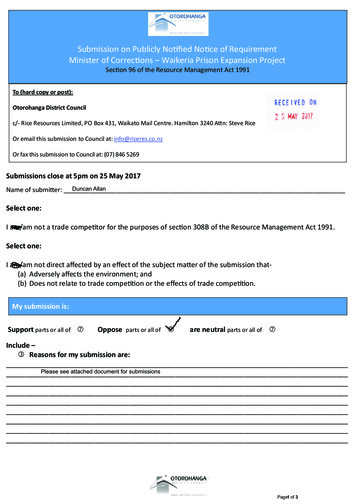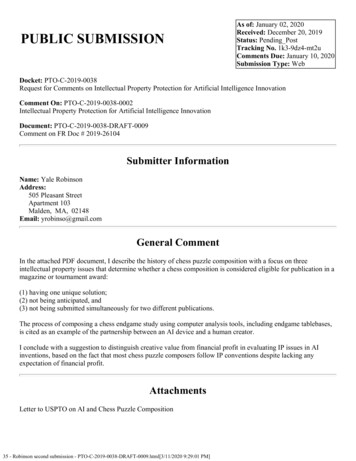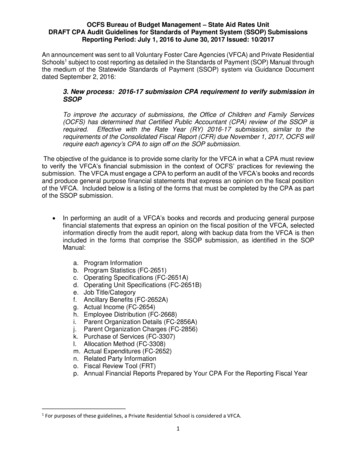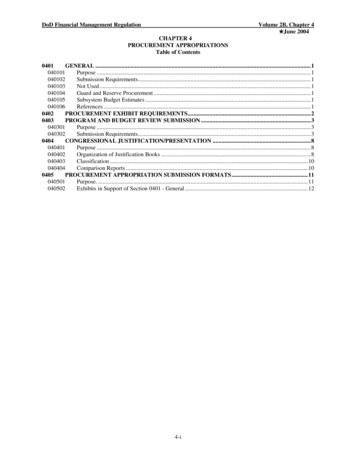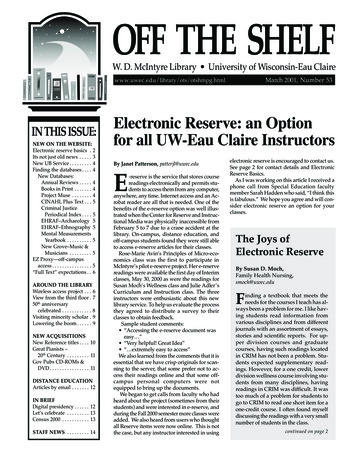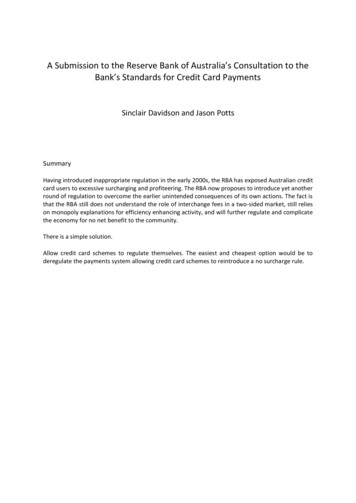
Transcription
A Submission to the Reserve Bank of Australia’s Consultation to theBank’s Standards for Credit Card PaymentsSinclair Davidson and Jason PottsSummaryHaving introduced inappropriate regulation in the early 2000s, the RBA has exposed Australian creditcard users to excessive surcharging and profiteering. The RBA now proposes to introduce yet anotherround of regulation to overcome the earlier unintended consequences of its own actions. The fact isthat the RBA still does not understand the role of interchange fees in a two-sided market, still relieson monopoly explanations for efficiency enhancing activity, and will further regulate and complicatethe economy for no net benefit to the community.There is a simple solution.Allow credit card schemes to regulate themselves. The easiest and cheapest option would be toderegulate the payments system allowing credit card schemes to reintroduce a no surcharge rule.
On 3 December 2015 the Reserve Bank of Australia (RBA) called for formal written submissions intoits draft surcharging and interchange standards. The RBA describes its framework for credit cardsurcharging as follows:1 Card schemes will not be permitted to make rules that prevent merchants fromrecovering part or all of the costs of accepting card payments.However, card acceptance costs will be defined more narrowly than in the Bank'scurrent guidance note, as the merchant service fee and other fees paid to themerchant's bank (or other payment service provider).Statements provided by banks to merchants will be required to contain easy-tounderstand information on the average cost of acceptance for each paymentmethod, which will constitute the maximum permissible surcharge if the merchantchooses to surcharge.These statements will express acceptance costs in percentage terms, except where amerchant's cost of acceptance for a particular payment method is fixed across alltransaction values. This should ensure that merchants – including in the airlineindustry – who wish to surcharge will typically do so in percentage terms rather thanas a fixed dollar amount. In this submission we address these points. Our argument is that the RBA has misunderstood theeconomics of interchange fees, and that its regulation of interchange fees has been entirelymisguided. As such the RBA has created conditions whereby merchants have been able to profiteerfrom consumer payment choices. Rather than add an additional layer of complex and difficult-toadminister regulation the RBA should simply allow card schemes to reintroduce no surcharge rules.There is no public interest in having government regulators or government agencies regulate privatebusiness costs.Merchants Incur Many CostsThe RBA predicates its regulation on the following observation: 2Merchants incur costs when they process a payment from a customer and differentpayment methods can have very different costs. When merchants have the right to apply a surcharge to more expensive paymentmethods they are able to provide price signals that encourage consumers to usepayment methods that are less expensive.This observation is trite. Merchants incur a multitude of costs when engaging in a transaction withconsumers. Those merchants that are able to charge a price in excess of their costs earn a profitand those merchants that cannot charge a price in excess of their costs experience losses. Paymentchoice is just one of the many costs incurred when doing business. The RBA has never provided anyexplanation as to why consumers should consider merchant costs when making purchasingdecisions. In particular there is no explanation why the payment system cost is more importantthan, say, labour costs, or rental costs, or some or other overhead cost. Consumers make purchasingdecisions based on their subjective valuation and preferences.1
The Economics of Interchange FeesInterchange fees are fees that banks charge each other as a result of their respective clients enteringinto a credit card transaction. Credit card transactions are usually described as being “two-sidedmarkets”. Credit card companies have to simultaneously meet the needs of two sets of end-users;consumers who employ credit cards as a payment mechanism, and merchants who accept credit cardsas a payments mechanism. Interchange fees act as a mechanism to balance the competing interestsof both consumers and merchants.Rochet and Tirole (2003) provide an excellent exposition of interchange fees and the relationshipcreated in a two-sided credit card market.3Figure 1: Rochet and Tirole depiction of an interchange feeSource: Rochet and Tirole (2003: 74)This depiction shows the net cash flows in the various relationships. The consumer (cardholder) buysgoods and services from the merchant. The consumer then pays the price (p) and a net fee to hisfinancial institution (Issuer). The consumer’s financial institution then pays the price (p) less theinterchange fee (a) to the merchant’s financial institution (Acquirer) who then pays the merchant theprice (p) less their own net fee.If both financial institutions are to remain profitable then m a. The merchant pays the interchangefee, i.e. the interchange fee is a cost of doing business that the merchant has to bear, when dealingwith a consumer who chooses to pay by credit card. By contrast, the merchant does not have to bearthat additional cost when dealing with a consumer who chooses to pay by cash. In theory this meansthat the profitability of the two types of transaction will be different – the merchant will earn a lowerprofit when accepting a credit card than they would when accepting cash. The implication then is thatin order to earn a given level of profit merchants will increase their prices for all consumers. Despitethis reasoning relying on some very strict ceteris paribus assumptions, the RBA has taken to describingthat profit differential as a subsidy from cash consumers to credit card consumers. In this the RBA isfollowing Stephen King.4And under a no-surcharge rule, these fees get hidden in the retail price and paid by allconsumers. So under a no-surcharge rule, customers who pay by direct debit, cash or2
some other non-credit means, also pay for your reward points. Credit card users may liketo force other consumers to pay for their reward points. But I doubt that such a hiddencross subsidy passes too many people’s concept of fairness.Unfortunately Professor King produces no evidence to support the view that a No-Surcharge ruleresults in higher prices, as opposed to lower merchant profitability. If the RBA has ever been able toshow that eliminating the No-Surcharge rule resulted in lower consumer prices that evidence is not inthe public domain. In fact the RBA has admitted, “It is impossible – given the imprecision in anyeconometric model of consumer price inflation – to measure exactly how these reductions inmerchant service fees have flowed through into prices for consumers.” 5 We note that since January2003, when the No-Surcharge Rule was eliminated, that the Consumer Price Index has increased from78.6 in the March quarter of that year to 108 in the September quarter of 2015.In any event Professor King’s more recent comments on the No-Surcharge Rule appear inconsistentwith his previous work in collaboration with Professor Joshua Gans:6In the absence of a no surcharge rule, cooperative setting of interchange fees cannothave any anticompetitive effect.Even in the presence of a no surcharge rule, the setting of interchange fees only createscompetitive concerns if there is inadequate retail level competition.Given that neither Professor King nor the RBA have produced any evidence to support the notion of“inadequate retail level competition” in Australia, it seems very unlikely that a no surcharge rulecreates any competitive concerns. It is not immediately clear that there is any competition policyrationale for regulating either interchange fees or eliminating the No-Surcharge Rule.If we accept there is an efficiency explanation for the emergence of the interchange fee (see Davidsonand Potts 2015a7), and note the fact that merchants, in the absence of regulation, tend to pay theinterchange fee, then it is clear that merchants benefit more from credit card paying consumers thanthe foregone profits that a static analysis would suggest. In order for merchants to benefit fromincreased purchases from credit card consumers and for credit card companies to earn a profit byissuing credit cards, the increased profitability must be shared by credit card paying consumers. Thisis done by the merchant paying the interchange fee that in turn is used to provide reward benefits tocredit card consumers. On this dynamic logic it is just as likely that credit card consumers expand thesize and scope of the market and actually reduce prices that cash consumers pay. In this instance creditcard consumers are subsidising cash consumers.That relationship is guaranteed when the merchant is unable to explicitly price discriminate betweenconsumers on the basis of payment method. A no surcharge rule protects the integrity of the twosided market, and prevents free-riding on the part of (some) merchants. Those retail associations thathave campaigned against interchange fees and/or no surcharge rules have been promoting free-ridingwith all the economic costs associated with that phenomenon.If individual merchants did associate credit card payments with overall lower profitability there isnothing to stop them from: Refusing to accept credit card payments; or,Offering credit card consumers a discount for paying in cash.3
Viewing the interchange fee relationship through an efficiency lens rather than a monopoly powerlens leads to the conclusion that interchange fees are a mechanism to facilitate greater trade andcommerce and the no surcharge rule exists to prevent free-riding.An Accounting Cost is not an Economic CostThe RBA proposes that the (average) accounting cost of accepting a credit card as payment be themaximum surcharge that a merchant can levy if choosing to surcharge. This proposal in no wayovercomes the free-rider problem, it simply deflects criticism from the merchant and onto their bank.The underlying logic of this proposal is that the consumer should bear the cost of making a paymentto the merchant and not the merchant. Yet it is not clear why a government agency should determinethe incidence of costs in a private transaction – that incidence itself could and should be up fornegotiation by the parties to the transaction. In any event, the RBA proposes that an accounting costbe employed as the surcharge amount; but it is well-known that accounting costs are crude proxiesfor economic costs.Cost-Based PricingPrior to the “marginal revolution” in the early 1870s economists believed that prices weredetermined by input costs. The most famous variation of this view is the so-called labour theory ofvalue. This approach to pricing is intuitively simple and easy to explain, yet it is not good businesspractice. Consumers do not value goods and services based upon their input prices, but rather onthe subjective value those goods and services provide to the consumer. The RBA proposal mandatesthat businesses follow poor practice rather than enter into voluntary transactions with credit cardproviders and credit card consumers.Economic costs are incurred by individuals when making a decision.8 They are subjective and veryoften unobservable. Objective and observable costs can only ever be the explicit after-the-fact coststhat accountants can record. But a merchant making a sale does not compete on accounting costs,merchants compete on opportunity and economic costs. The decision to accept a credit card payment,for example, may facilitate the entire transaction. The opportunity cost of accepting or not acceptingthe credit card may not be the accounting cost of the credit card transaction, but rather losing theentire transaction. In this instance the wise merchant may choice to lower the surcharge, or indeedwaive the surcharge. In this instance it becomes yet another margin of competition. An accountingtreatment, however, may well see a diminishing of competition. At the very least it may reducemerchant demand for more efficient and cheaper payment technologies.A further complication is that the cost of accepting a credit card will be consumer, firm, and contextspecific. Employing average accounting costs will mask the context specific situations consequentlystill exposing consumers to the hazards of excessive surcharging. The RBA will have to closely monitorand effectively second-guess the surcharging rates of nearly every merchant that chooses tosurcharge. For example the cost of accepting a credit card payment from a highly credit-worthyindividual who makes a purchase from a large firm must be very low to the banking system. By contrastthat some transaction made by a less credit-worthy individual would be more expensive. So too if thecredit-worthy individual made the same transaction at a small firm (or even a rural firm). It is simplynot clear that allowing merchants to impose an average accounting cost as a surcharge will overcomeany of these difficulties or provide any of the price signals that the RBA anticipates.4
Just Another FuelWatch Scheme?What the RBA proposes is very much like the discredited 2008 FuelWatch scheme proposed by theformer Labor government. The proposal was that petrol retailers would be able to fix petrol pricesfor a 24 hour period to provide certainty to petrol consumers. What the RBA proposes is: 9If merchants wish to surcharge for a particular payment method, they will use theinformation from their payments provider to determine the maximum permissiblesurcharge for each system. Merchants will be able to use the information on theiraverage payment cost over a financial year to set their surcharge for the following year.The RBA proposes that merchants fix their prices for a year based on lagged accounting costs. It isnot at all clear how this will provide consumers with transparent price signals – especially ifconsumers are unable to inspect merchants’ annual bank statements.The RBA Should Not Regulate Payments SystemsThe RBA justifies its regulation of payment systems on anti-monopoly grounds:10Where merchants feel unable to decline particular cards (because consumers expect tobe able to pay by that card and may take their business elsewhere if they cannot), theincentive is for card schemes to raise interchange rates.This statement is entirely inconsistent with commercial reality. As any American Express card-holderknows merchants do not “feel unable to decline particular cards”. The decision to accept credit cardpayments is a commercial decision that merchants make – there is no justification for the RBA tosecond-guess those commercial decisions. In any event, the RBA statement is contradicted by theevidence reported in the 2000 joint RBA-ACCC analysis of Debit and Credit Card Schemes in Australia:11Interchange fees for MasterCard and Visa were last changed in the early 1990s. Australianmembers of each of the two schemes commissioned a review of the respective fees inthe mid 1990s but no changes to fees resulted. Interchange fees for Bankcard have notchanged since 1974.As we have argued before (Davidson and Potts 2015b 12) the RBA is poorly placed to regulate thepayments system. The economics of industry regulation, including the payments system, is a verydifferent branch of economic theory and practice from monetary economics (the RBA’s primaryspecialisation). It is entirely based in microeconomic theory (not macroeconomic theory) and isfocused on market behaviour under different degrees of competition and often incorporatestransaction cost economics, models of technological and entrepreneurial competition, and models ofstrategy. Regulation of the payments system rules, including the bank interchange fee, is an issue ofindustrial organization, and competition policy. This is not the RBAs natural domain of competence.5
Vague Benefits, Unknown ConsequencesThe RBA is remarkably vague when describing the benefits of its new policy setting:The proposed reforms announced by the Government and the Reserve Bank will meanthat consumers may still pay surcharges on some payment cards, but where they do,surcharges will be no more than the amount the merchant pays its bank or paymentsprovider to accept that type of card.Consumers are still paying a surcharge.The proposed changes are likely to result in some reductions in the generosity ofrewards programs on premium and companion cards and in the size of rebates paid oncommercial cards. It is also possible that there may be some adjustment in annual feeson these cards.While still paying a surcharge, consumers will also receive fewer reward points while incurringhigher bank fees.Banks and payments providers will have to ensure that the regular statements thatthey provide to merchants contain information on the average cost of each debit andcredit card system. Merchants will also receive an annual statement at the end of eachfinancial year that outlines the average cost of each payment method over theprevious year.The regulatory compliance burden for merchants and financial institutions will increase.Hence, there should be little, if any, effect on interchange revenues of the smallerinstitutions, so little need for change to their business models.The proposed policy will not benefit smaller financial institutions.Small and medium-sized merchants should see a material reduction in merchantservice fees from the Bank's proposed reforms. This should improve theircompetitiveness relative to larger merchants who benefit from low interchange rateson all their card transactions.It is unclear why these merchants – who seemingly are unable to surcharge now – will be able tosurcharge after the proposed policy introduction. If larger merchants are being forced to effectivelylower their prices (by lowering their surcharge) how does this make smaller merchants morecompetitive?6
About the AuthorsSinclair Davidson is Professor of Institutional Economics in the School of Economics, Finance andMarketing at RMIT University, and a Senior Fellow at the Institute of Public Affairs. He is a regularcontributor to public debate. His opinion pieces have been published in The Age, The Australian,Australian Financial Review, Sydney Morning Herald, and Wall Street Journal Asia. Sinclair haspublished in academic journals such as the European Journal of Political Economy, Journal of EconomicBehavior and Organization, and the Cato Journal.Jason Potts is Professor of Economics in the School of Economics, Finance and Marketing at RMITUniversity, an Australian Research Council Future Fellow, and also an Adjunct Fellow at the Instituteof Public Affairs. He has written five books and over 70 articles on the theory of economic evolution.His work focuses on how entrepreneurship and innovation drive economic growth and development.Jason has published in academic journals such as Journal of Economic Behavior and Organisation,Journal of Institutional Economics, and Economic n.html3Jean-Charles Rochet and Jean Tirole, 2003, An economic analysis of the determination of interchange fees inpayment card systems, Review of Network Economics, 2(2): 69 – rve Bank of Australia. 2015. Review of card payments regulation: Issues paper. March 2015.6Joshua Gans and Stephen King, 2003, The neutrality of interchange fees in payment systems, Topics in economicanalysis & policy, 3(1): online.7Sinclair Davidson and Jason Potts, 2015a, Australian Interchange Fee Regulation: A Regulation in Search ofMarket Failure, Appendix 1 below.8See James M Buchanan, 1975, Cost and Choice, Liberty e Bank of Australia and Australian Competition and Consumer Commission, 2000, Debit and Credit cardschemes in Australia: A study on interchange fees and access, pg. 43.12Sinclair Davidson and Jason Potts, 2015b, Who Should Regulate the Bank Interchange Fee: The RBA or theACCC? Appendix 2 below.27
Appendix 1: Australian Interchange Fee Regulation:A Regulation in Search of Market Failure
About the AuthorsSinclair Davidson is Professor of Institutional Economics in the School ofEconomics, Finance and Marketing at RMIT University, and a SeniorFellow at the Institute of Public Affairs. He is a regular contributor topublic debate. His opinion pieces have been published in The Age, TheAustralian, Australian Financial Review, Sydney Morning Herald, andWall Street Journal Asia. Sinclair has published in academic journalssuch as the European Journal of Political Economy, Journal of EconomicBehavior and Organization, and the Cato Journal.Jason Potts is Professor of Economics in the School of Economics,Finance and Marketing at RMIT University, an Australian ResearchCouncil Future Fellow, and also an Adjunct Fellow at the Institute ofPublic Affairs. He has written five books and over 70 articles on thetheory of economic evolution. His work focuses on how entrepreneurshipand innovation drive economic growth and development. Jason haspublished in academic journals such as Journal of Economic Behaviorand Organisation, Journal of Institutional Economics, and EconomicAffairs.1Australian Interchange Fee Regulation: a regulation in search of market failure.
Executive SummaryThe Reserve Bank of Australia has been a world leader in interchange fee regulation. In this paper wesuggest that this regulatory intervention has been based on wishful thinking at best and represents afailure to understand the actual working of the market economy.In short, the Reserve Bank of Australia engaged in an extensive regulatory intervention based on poortheory, and no empirical evidence. Theory has not provided an unambiguous indication of marketfailure, and there is no empirical evidence to support the notion of monopoly pricing – other than avague notion that interchange fees were “excessive”. What the Reserve Bank identified as being“externality” any fair minded observer would label “gains from trade”.We argue that interchange fees are the outcome of an efficient bargaining process given that banksand consumers, and banks and merchants form long term relationships with each other. For as long asthere is competition in the banking sector and competition in the retail sector, the interchange fee itselfis subject to competitive pressure.There is no market failure and no economic justification for government intervention. The 13 billion“saving” to merchants that the Reserve Bank identifies following its regulatory reform is simply aredistribution away from consumers (and banks) towards merchants. The Reserve Bank assumes thatthe saving has been passed onto consumers, but cannot provide any evidence to support thathypothesis.It is not at all clear that consumers have benefited from interchange fee regulation. To the contrary islikely that consumers are worse off – while merchant fees have declined, so too have the benefits ofusing credits while the costs (including the interest rate premium over the cash) have increased.2Australian Interchange Fee Regulation: a regulation in search of market failure.
1. IntroductionRonald Coase famously argued that “if an economist finds something – a business practice of one sortor other – that he does not understand, he looks for a monopoly explanation”.1 So it is with credit cardinterchange fees. As we will demonstrate intellectual confusion has lead to the phenomenon ofinterchange fees being misdiagnosed as being a monopoly problem leading to inappropriate policyintervention. Following George Stigler’s path breaking analysis of the US Security and ExchangeCommission he claimed that financial regulation was “founded upon prejudice and reforms aredirected by wishfulness”.2 In our opinion, Australian regulation of interchange fees should be placedinto the same category: reforms initiated by ignorance and anti-bank prejudice.A 2000 joint study by the Reserve Bank and Australian Consumer and Competition Commissionconcluded inter alia:3, 4IICredit card interchange fees are significantly above levels suggested by cost-basedmethodologies and contribute to margins of revenues over average costs of around 39 per cent for cardissuers. IV‘No surcharge’ rules in credit card schemes prevent purchasers from confronting the cost ofthis payment instrument vis-à-vis lower cost payment instruments such as debit cards. It means thatother consumers subsidise credit cardholders and financial institutions which are card schememembers. An alternative arrangement would have merchants exercising discretion to charge customersprices that are net of the cost of the payment instrument, and add a surcharge to cover that cost.V Competition in credit card issuing and acquiring is limited by restrictions on access to credit cardschemes. Excluding all institutions other than authorised deposit-takers from access to acquiring, inparticular, is difficult to justify on risk grounds. Interchange fees are set by card issuers and acquirers at ‘one step removed’ from the cardholders andmerchants who ultimately bear these fees through transaction charges or through the general cost ofgoods and services. Users therefore do not have a direct influence on the pricing of card paymentservices but must rely on their financial institutions to represent their interests. As a consequence, theprice signals and competitive responses that would be expected to put pressure on margins in cardpayment networks have not worked effectively. These difficulties are reinforced by restrictions onaccess to the card networks, both explicit and informal, and by the ‘no surcharge’ rules in credit cardschemes.The regulatory concerns then relate to excessive pricing, price fixing, abuse of market power, thecreation of barriers to entry, increased consumers prices generally, and excessive use of credit cardsrelative to alternate payment methods. The fact that end-users do not observe the interchange fee1Coase, 1972 [1988], pg. 67.Stigler, 1964, pg. 142.3Reserve Bank and Australian Consumer and Competition Commission, 2000, pg. 73 – 74.4Hereinafter RBA – ACCC.23Australian Interchange Fee Regulation: a regulation in search of market failure.
makes it opaque, and less prone to competitive pressure. All these arguments suggest that regulatoryintervention can easily correct these apparent market flaws and result in improve economicperformance.As a result of these concerns and the apparent ease at which corrective action could be undertakenAustralia embarked on a program of regulatory intervention. In this paper, we argue that the regulatoryconcerns were over-sold and rely on a faulty understanding of the underlying economic principles.There is no case for intervention.The remainder of the paper is set out as follows. In section 2 we explain what an interchange fee is. Insection three we critique the Australian arguments for regulatory intervention and show data as toconsequences of that intervention. In section 4 we provide alternative, non-monopoly but efficiencyenhancing, explanations for interchange fees.2. What is an interchange fee?Interchange fees are fees that banks charge each other as a result of their respective clients enteringinto a credit card transaction. Figure 1 below shows how the Reserve Bank of Australia depicts aninterchange fee. The figure shows a stylised (four-party system) example of transactions involving acredit card.The consumer (cardholder) purchases goods and services from a merchant and pays for the goods andservice using a credit card. Underpinning that particular transaction is two prior transactions and a longterm relationship. The first prior transaction is between the consumer and their own financial institutionwhereby they acquire a credit card and pay a fee for the credit card use. As part of that transaction theconsumer may or may not earn reward points as a function of the credit card usage. The second priortransaction is between the merchant and their financial institution whereby the merchant pays a fee totheir financial institution in order to process credit card payments. The long-term relationship is betweenthe two financial institutions that provide financial services to the consumer and merchant.When the merchant sells goods and services to the consumer, the consumer authorises his financialinstitution to pay a sum of money to the merchant. The merchant passes the authorisation to his financialinstitution which then collects the money from the consumer’s financial institution and pays themerchant. Finally the consumer’s financial institution gets paid once the consumer pays off theiroutstanding credit card balance.55What is missing from the Reserve Bank explanation is that the consumer’s bank as extended credit to theconsumer while immediately paying the merchant’s bank. The risk of non‐payment is borne by the consumer’sbank.4Australian Interchange Fee Regulation: a regulation in search of market failure.
Figure 1: RBA depiction of an interchange feeSource: RBA 2015, pg. 6The interchange fee is a fee paid by the merchant’s bank to the consumer’s bank.Neoclassical economists describe this type of arrangement as being a “two-sided” market. Two-sidedmarkets consist of two sets of end-users who have their needs met simultaneously. In this case thecredit card example the two sets of users include consumers who use the credit (card holders) andmerchants who accept the card. The card
Sinclair Davidson and Jason Potts Summary Having introduced inappropriate regulation in the early 2000s, the RBA has exposed Australian credit . the credit card may not be the accounting cost of the credit card transaction, but rather losing the entire transaction. In this instance the wise merchant may choice to lower the surcharge, or indeed


